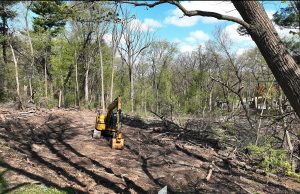Erosion control, restoration work resumes at Sinnissippi Park
May 19, 2023
Work has resumed in an $800,000 project designed to address erosion and open the existing vegetation canopy to improve oak and hickory tree regeneration at Rockford’s Sinnissippi Park. (Photo courtesy of Rockford Park District)
Efforts to address serious water erosion and protect Rockford’s Sinnissippi Park for present and future generations has resumed.
Visitors to the park, located at 1401 N. Second St., are reminded to be aware of potential road closures and barricades as work is expected to continue through summer.
The comprehensive project to address water erosion control issues began in March. Preservation of these areas is very important to the Rockford Park District and the work will help protect the park, Rock River Recreation Path and Sinnissippi Rose Garden for generations to enjoy.
Stabilizing the banks of the ravine is the first of many steps needed to ensure that proper drainage is in place.
Overall goals include opening the existing vegetation canopy which will allow for oak and hickory regeneration, native grass and vegetation growth, wildlife habitat maintenance and invasive species removal. Rockford Park District experts have also consulted a variety of ecological experts as well.
This erosion project is funded through $800,000 in State of Illinois Department of Commerce and Economic Opportunity (DCEO) money secured by State Rep. Maurice West (D-Rockford).
The project includes three phases:
Stabilization of Eroded Ravine in Sinnissippi Park
Undesirable trees and invasive shrubs will be removed along the ravine which will also open the tree canopy. Over many decades the oak woodlands has come under mesophication which allows undesirable species to exist which creates too much shade.
The first phase includes removing and harvesting 48 trees. Removal will help open the tree canopy to allow sunlight to reach native plant species that will be planted later this year as a part of this project. The Park District will utilize money from the tree harvest to help recoup project expenses. The second phase of the tree removal part of the project includes removing 18 trees that don’t have timber value.
Specific trees have been selected to remain and be protected to give the Park District the best chance of utilizing the seeds to grow new, desirable oak trees.
The ravine will be regraded, and water control structures will be put in place. Prairie plants will be installed along the ravine to stabilize soil and a retention basin will be built with wetland plants. In the future, the District will look at rebuilding the oak woodland.
Perennial Garden Erosion Repairs within Nicholas Conservatory & Gardens Campus
Removal of previously eroded sediment and re-grading work within the drainage swale located between the railroad and Perennial Garden, repair of the existing drain pipe and establishment of native grasses, sedges, and rushes.
Rock River Shoreline Repairs and Stabilization
Bank restoration work will repair sections of heavily eroded Rock River shoreline including installation of stone riprap material, a new trench drain and curbing to control overland storm water flow, and new fencing to protect pathway users.
Depending on weather and contractor availability, work should be complete by early summer.







